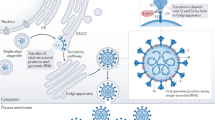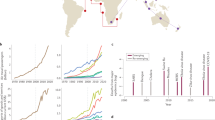Abstract
A novel H7N9 influenza A virus first detected in March 2013 has since caused more than 130 human infections in China, resulting in 40 deaths1,2. Preliminary analyses suggest that the virus is a reassortant of H7, N9 and H9N2 avian influenza viruses, and carries some amino acids associated with mammalian receptor binding, raising concerns of a new pandemic1,3,4. However, neither the source populations of the H7N9 outbreak lineage nor the conditions for its genesis are fully known5. Using a combination of active surveillance, screening of virus archives, and evolutionary analyses, here we show that H7 viruses probably transferred from domestic duck to chicken populations in China on at least two independent occasions. We show that the H7 viruses subsequently reassorted with enzootic H9N2 viruses to generate the H7N9 outbreak lineage, and a related previously unrecognized H7N7 lineage. The H7N9 outbreak lineage has spread over a large geographic region and is prevalent in chickens at live poultry markets, which are thought to be the immediate source of human infections. Whether the H7N9 outbreak lineage has, or will, become enzootic in China and neighbouring regions requires further investigation. The discovery here of a related H7N7 influenza virus in chickens that has the ability to infect mammals experimentally, suggests that H7 viruses may pose threats beyond the current outbreak. The continuing prevalence of H7 viruses in poultry could lead to the generation of highly pathogenic variants and further sporadic human infections, with a continued risk of the virus acquiring human-to-human transmissibility.
This is a preview of subscription content, access via your institution
Access options
Subscribe to this journal
Receive 51 print issues and online access
$199.00 per year
only $3.90 per issue
Buy this article
- Purchase on Springer Link
- Instant access to full article PDF
Prices may be subject to local taxes which are calculated during checkout


Similar content being viewed by others
References
Gao, R. et al. Human infection with a novel avian-origin influenza A (H7N9) virus. N. Engl. J. Med. 368, 1888–1897 (2013)
World Health Organization. Number of confirmed human cases of avian influenza A(H7N9) reported to World Health Organization; http://www.who.int/influenza/human_animal_interface/influenza_h7n9/08_ReportWebH7N9Number.pdf (2013)
Liu, D. et al. Origin and diversity of novel avian influenza A H7N9 viruses causing human infection: phylogenetic, structural, and coalescent analyses. Lancet 381, 1926–1932 (2013)
Kageyama, T. et al. Genetic analysis of novel avian A(H7N9) influenza viruses isolated from patients in China, February to April 2013. Euro Surveill. 18, 20453 (2013)
Hvistendahl, M., Normile, D. & Cohen, J. Influenza. Despite large research effort, H7N9 continues to baffle. Science 340, 414–415 (2013)
Guo, Y. J. et al. Characterization of the pathogenicity of members of the newly established H9N2 influenza virus lineages in Asia. Virology 267, 279–288 (2000)
Duan, L. et al. Influenza virus surveillance in migratory ducks and sentinel ducks at Poyang Lake, China. Influenza Other Respi. Viruses 5 (suppl. 1). 65–68 (2011)
Tharakaraman, K. et al. Glycan receptor binding of the influenza A virus H7N9 hemagglutinin. Cell 153, 1486–1493 (2013)
Xiong, X. et al. Receptor binding by an H7N9 influenza virus from humans. Nature 499, 496–499 (2013)
Cheung, C. L. et al. Establishment of influenza A virus (H6N1) in minor poultry species in southern China. J. Virol. 81, 10402–10412 (2007)
Yamada, S. et al. Biological and structural characterization of a host-adapting amino acid in influenza virus. PLoS Pathog. 6, e1001034 (2010)
Zhu, H. et al. Infectivity, transmission, and pathology of human-isolated H7N9 influenza virus in ferrets and pigs. Science 341, 183–186 (2013)
Xu, J., Lu, S., Wang, H. & Chen, C. Reducing exposure to avian influenza H7N9. Lancet 381, 1815–1816 (2013)
Shortridge, K. F. et al. Interspecies transmission of influenza viruses: H5N1 virus and a Hong Kong SAR perspective. Vet. Microbiol. 74, 141–147 (2000)
Anisimova, M., Gil, M., Dufayard, J. F., Dessimoz, C. & Gascuel, O. Survey of branch support methods demonstrates accuracy, power, and robustness of fast likelihood-based approximation schemes. Syst. Biol. 60, 685–699 (2011)
Guindon, S. et al. New algorithms and methods to estimate maximum-likelihood phylogenies: assessing the performance of PhyML 3.0. Syst. Biol. 59, 307–321 (2010)
Stamatakis, A. RAxML-VI-HPC: maximum likelihood-based phylogenetic analyses with thousands of taxa and mixed models. Bioinformatics 22, 2688–2690 (2006)
Drummond, A. J., Suchard, M. A., Xie, D. & Rambaut, A. Bayesian phylogenetics with BEAUti and the BEAST 1.7. Mol. Biol. Evol. 29, 1969–1973 (2012)
Murrell, B. et al. Detecting individual sites subject to episodic diversifying selection. PLoS Genet. 8, e1002764 (2012)
Pond, S. L., Frost, S. D. & Muse, S. V. HyPhy: hypothesis testing using phylogenies. Bioinformatics 21, 676–679 (2005)
Pupko, T., Pe’er, I., Shamir, R. & Graur, D. A fast algorithm for joint reconstruction of ancestral amino acid sequences. Mol. Biol. Evol. 17, 890–896 (2000)
Huang, K. et al. Establishment and lineage replacement of H6 influenza viruses in domestic ducks in southern China. J. Virol. 86, 6075–6083 (2012)
Edgar, R. C. MUSCLE: multiple sequence alignment with high accuracy and high throughput. Nucleic Acids Res. 32, 1792–1797 (2004)
Drummond, A. J., Ho, S. Y., Phillips, M. J. & Rambaut, A. Relaxed phylogenetics and dating with confidence. PLoS Biol. 4, e88 (2006)
Shapiro, B., Rambaut, A. & Drummond, A. J. Choosing appropriate substitution models for the phylogenetic analysis of protein-coding sequences. Mol. Biol. Evol. 23, 7–9 (2006)
Minin, V. N., Bloomquist, E. W. & Suchard, M. A. Smooth skyride through a rough skyline: Bayesian coalescent-based inference of population dynamics. Mol. Biol. Evol. 25, 1459–1471 (2008)
Lam, T. T. et al. Systematic phylogenetic analysis of influenza A virus reveals many novel mosaic genome segments. Infect. Genet. Evol. 18, 367–378 (2013)
Delport, W., Poon, A. F., Frost, S. D. & Kosakovsky Pond, S. L. Datamonkey 2010: a suite of phylogenetic analysis tools for evolutionary biology. Bioinformatics 26, 2455–2457 (2010)
Acknowledgements
We thank our colleagues from the Joint Influenza Research Centre (SUMC/HKU) and the State Key Laboratory of Emerging Infectious Diseases for their technical assistance. This study was supported by the National Institutes of Health (National Institute of Allergy and Infectious Diseases contract HSN266200700005C), Li Ka Shing Foundation, the Area of Excellence Scheme of the University Grants Committee of the Hong Kong SAR (grant AoE/M-12/06), Shenzhen Peacock Plan High-End Talents Program (KQTD201203), the University Development Fund (HKU) and the Innovation and Technology Commission of the Hong Kong Government. T.T.-Y.L. was supported in part by a Newton International Fellowship of the Royal Society. Metabiota's involvement was supported by the US Agency for International Development (USAID) Emerging Pandemic Threats Program, PREDICT project, under the terms of Cooperative Agreement Number GHN-A-OO-09-00010-00. The research leading to these results has received funding from the European Union Seventh Framework Programme (FP7/2007-2013) under Grant Agreement no. 278433-PREDEMICS, ERC Grant agreement no. 260864 and the Wellcome Trust (grant 092807) to A.R. and S.J.L.
Author information
Authors and Affiliations
Contributions
Y.G., H.Z. and T.T.-Y.L. conceived the study; J.W., Y. Shen, B.Z., L.D., C.Y.-H.L., W.H., Z.O. and X.C. conducted surveillance; H.Z., J.W., C.-L.C., C.M., L.L., Y.C., L.Z., H.L., Y.L., A.F. and D.J.K. performed virus isolation, sequencing and animal experiments; T.T.-Y.L., A.R., O.G.P., H.Z., D.K.S., S.J.L., L.L.M.P., J.S.M.P., G.M.L., Y. Shu, R.G.W, R.J.W. and Y.G. contributed to the analysis; D.K.S. and T.T.-Y.L. wrote the manuscript; Y.G., H.Z., O.G.P. and A.R. edited the manuscript.
Corresponding authors
Ethics declarations
Competing interests
The authors declare no competing financial interests.
Supplementary information
Supplementary Information
This file contains Supplementary Figures 1-14, a Supplementary Discussion and Supplementary Tables 1-5. (PDF 5824 kb)
PowerPoint slides
Rights and permissions
About this article
Cite this article
Lam, TY., Wang, J., Shen, Y. et al. The genesis and source of the H7N9 influenza viruses causing human infections in China. Nature 502, 241–244 (2013). https://doi.org/10.1038/nature12515
Received:
Accepted:
Published:
Issue Date:
DOI: https://doi.org/10.1038/nature12515
This article is cited by
-
Synchrony of Bird Migration with Global Dispersal of Avian Influenza Reveals Exposed Bird Orders
Nature Communications (2024)
-
Molecular characterization of the whole genome of H9N2 avian influenza virus isolated from Egyptian poultry farms
Archives of Virology (2024)
-
Assessing compatibility and viral fitness between poultry-adapted H9N2 and wild bird-derived neuraminidases
Scientific Reports (2023)
-
Leveraging machine learning to assess market-level food safety and zoonotic disease risks in China
Scientific Reports (2022)
-
Rapid emergence of a PB2 D701N substitution during adaptation of an H9N2 avian influenza virus in mice
Archives of Virology (2022)
Comments
By submitting a comment you agree to abide by our Terms and Community Guidelines. If you find something abusive or that does not comply with our terms or guidelines please flag it as inappropriate.



